
Digital customer journey stages exposed: From awareness to purchase and beyond
Key takeaways
Understand the digital customer journey, its five phases and different examples
Learn effective methods to optimize throughout the digital customer journey
Discover how digital experience intelligence tools work and take insights further
What is the digital customer journey?
The digital customer journey captures the five steps a consumer takes on their path to conversion, such as purchase. This includes all customer touchpoints where there is engagement–from interest in the product, to making contact with the brand and the further path down the journey to purchase.
It’s important to know that once the sale is made, the journey continues to the “end”—this is where customer loyalty strategies encourage customers to repeat buying from their company in the future and creating referrals to their business.
All of these customer touchpoints are essential to a brand because most customers need to be exposed to and engage with a brand or product many times before they decide to click “buy.” These touchpoints can include both physical and digital marketing efforts—from physical and online ads, to reviews to word-of-mouth recommendations and more.
It’s also critical to understand that within each user’s journey, there are multiple touchpoints, and they may go back and forth between them, zig-zagging towards a purchase. For instance, 87% start their research online, but they may visit a store to see the product, request product information from your website, and then compare the shop on their mobile device.
The importance of digital customer journeys in today’s world
In the traditional world of marketing, organizations started off with a product, did some TV or radio ads, and then customers went to brick and mortar shops to choose among brands and buy a product.
Today’s digital customer experience is vastly different. There are many more touch points to connect with consumers. They are exposed to digital media channels (Facebook, Twitter, YouTube, etc.) and an array of online platforms (websites, forums, blogs, etc.).
There are also many more ways to buy the product, including through a website, mobile app, in the physical store–or even a combination of these with the rise of click and collect. Now we’re even ordering with our voice via our voice-assisted devices.
The average household today has more than 22 connected devices. Our customer journey—from awareness to purchase—has become one of many pathways and multiple devices.
And each of these devices has multiple points of interaction. From calls and texts to messaging apps, social media, Spotify and browsing on Amazon, the average person spends 5 hours and 24 minutes on their phone each day. And at least 79% of smartphone users have made a purchase using their mobile device over the past 6 months.
Think about the last product you bought. How many times did you interact with the brand online as you did your research? How many times did you visit the brand’s website before you bought? Did you interact with their web chat or online help?
Clearly there are more online touchpoints and digital customer journey stages than ever before, and businesses need a way to follow, map and understand this customer journey from beginning to end.
The different stages of the digital customer journey
One of the biggest challenges for companies is understanding motivations and influences that drive a prospect to become a customer. That information is critical to improving the digital customer journey from awareness through advocacy.
Each pathway to purchase will be different, but at some point they’ll go through these stages.
Awareness: This is the discovery phase. A consumer determines that they have a need for a product and starts investigating solutions. This is when people turn to the web to do research, looking at a variety of content–from articles to blogs to other educational content. This is the time you want to be noticed.
Consideration: During this stage, a consumer will start comparing different solutions and evaluate the pros and cons. This phase may involve visiting your website, attending a webinar, requesting a free trial and other actions to move closer to a decision. Ideally, the consumer is looking at your product as a viable solution to their needs.
Decision/purchase: This stage is that pivotal moment when the potential buyer has decided that your product is the best choice and wants to buy it. They will create an account, start shopping and buy your product. During this all-important decision phase, the overall experience will influence future behavior–the speed of purchase, delivery and communication.
Retention/loyalty: Once the shopper has moved to buyer, this is the time to nurture them to be a loyal customer. Post-purchase, the product should work as expected or exceed expectations and include strong support as needed. It’s also the time to optimize opportunities for future purchases, leveraging digital analytics to personalize pages, offer rewards and other loyalty techniques.
Advocacy: This phase of the customer journey pushes your brand forward through the power of a happy customer. This customer has established an emotional connection with your company, will purchase in the future and recommends your product to others through word-of-mouth referrals, reviews, customer generated content and other endorsements.
To retain customers and turn them into advocates, you need to understand how they really experience your brand or product. Customer journey analytics can help you see where customers are struggling, dropping off and errors across your website or app so you can optimize the customer journey and keep customers happy and build loyalty.
Examples of digital customer journeys
Every company has five stages to the digital customer journey, but the path to purchase and beyond will depend on the product and touchpoints in the process. Here are examples from different industries that illustrate the variety of strategies and approaches.
Retail and e-commerce digital customer journey examples
Online holiday gift purchase

Online cosmetics purchase
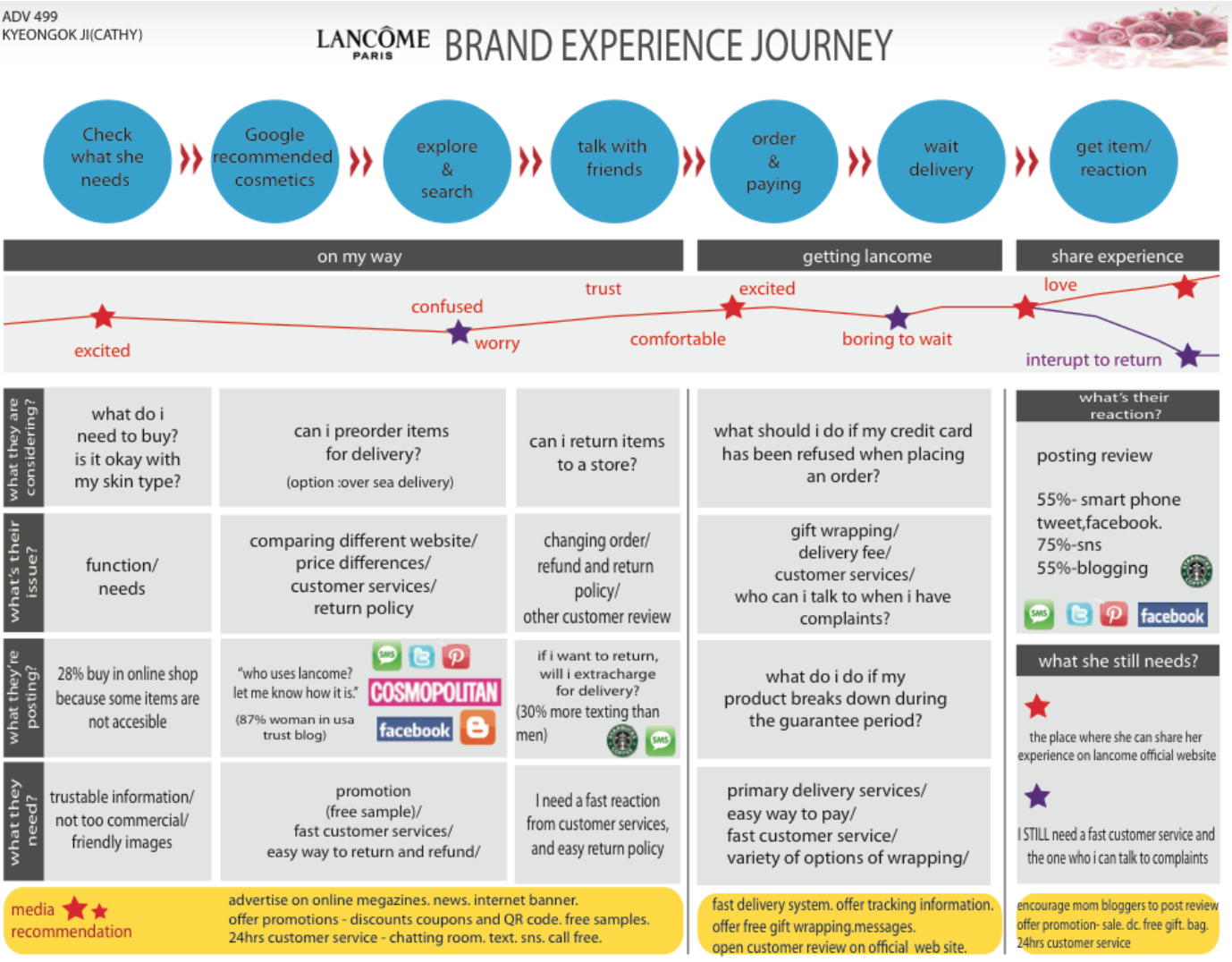

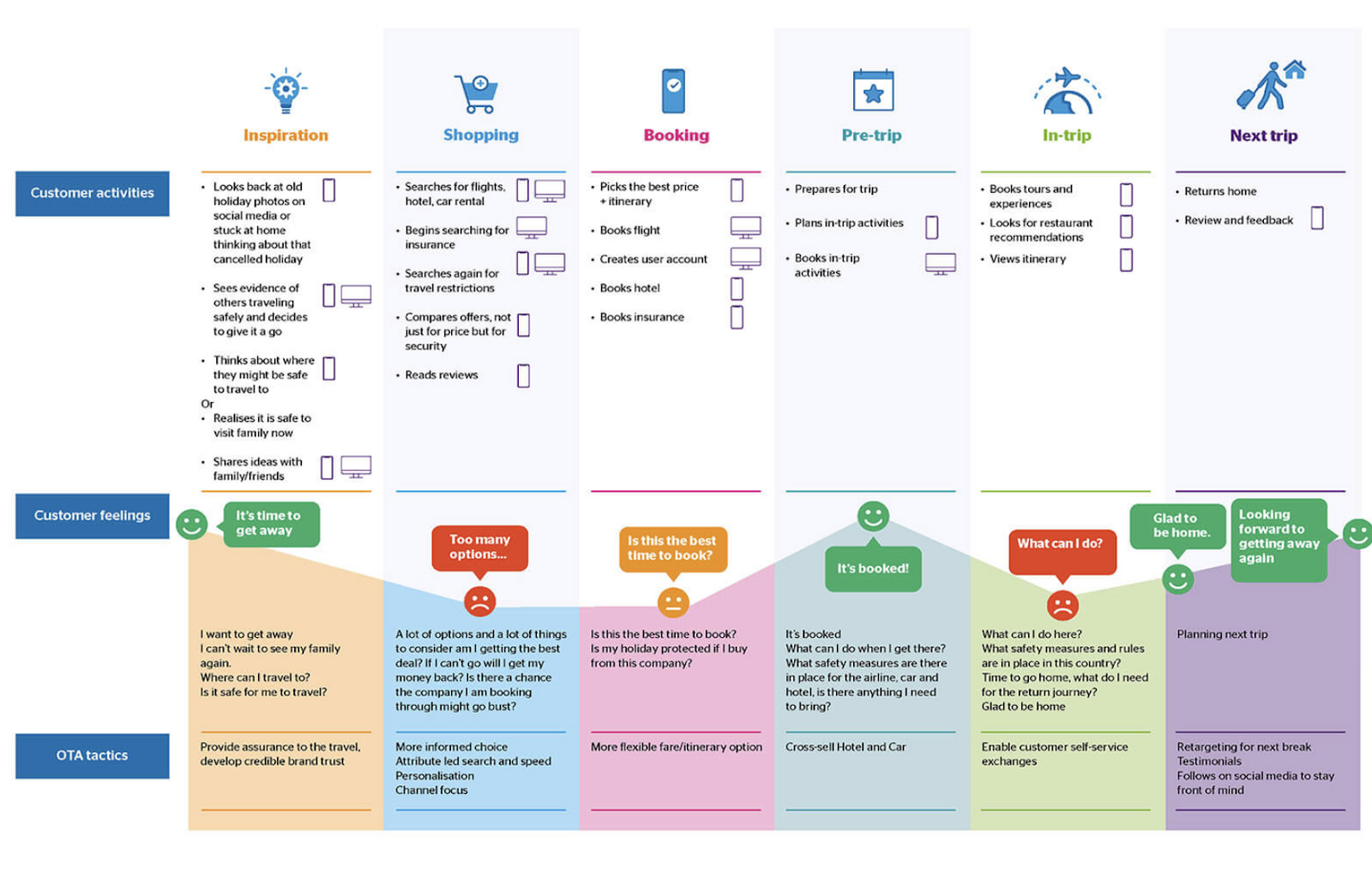
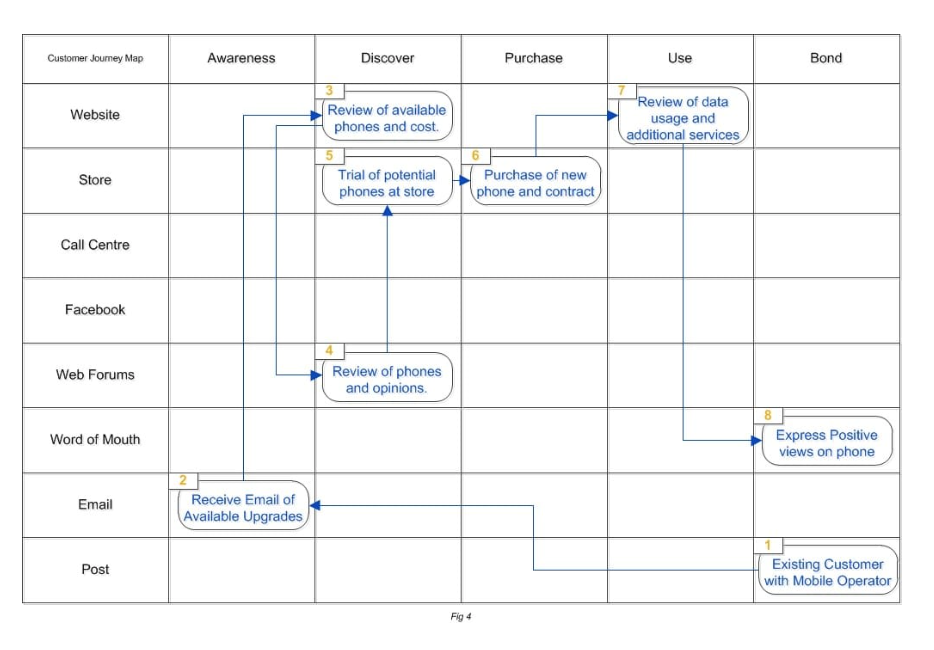
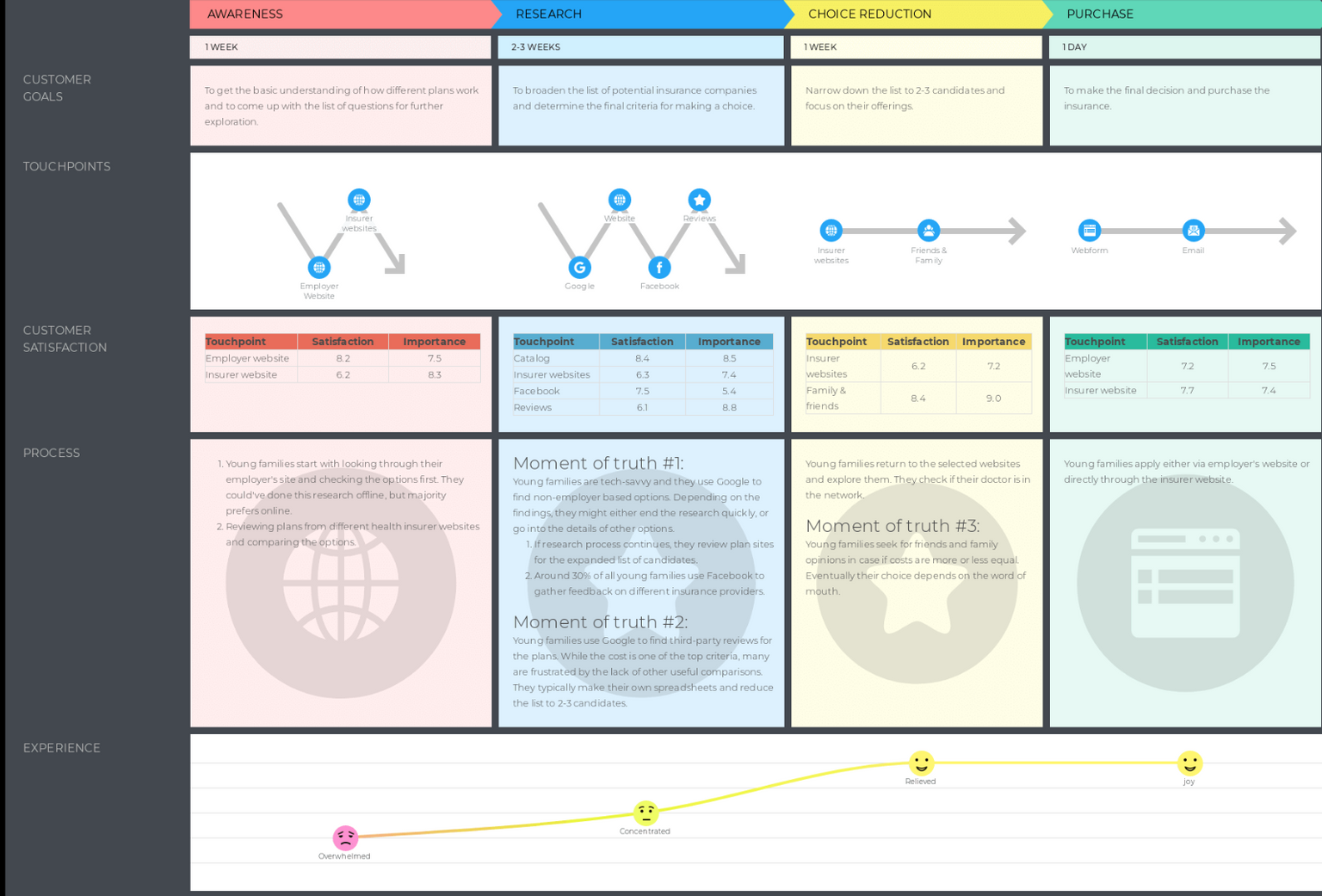
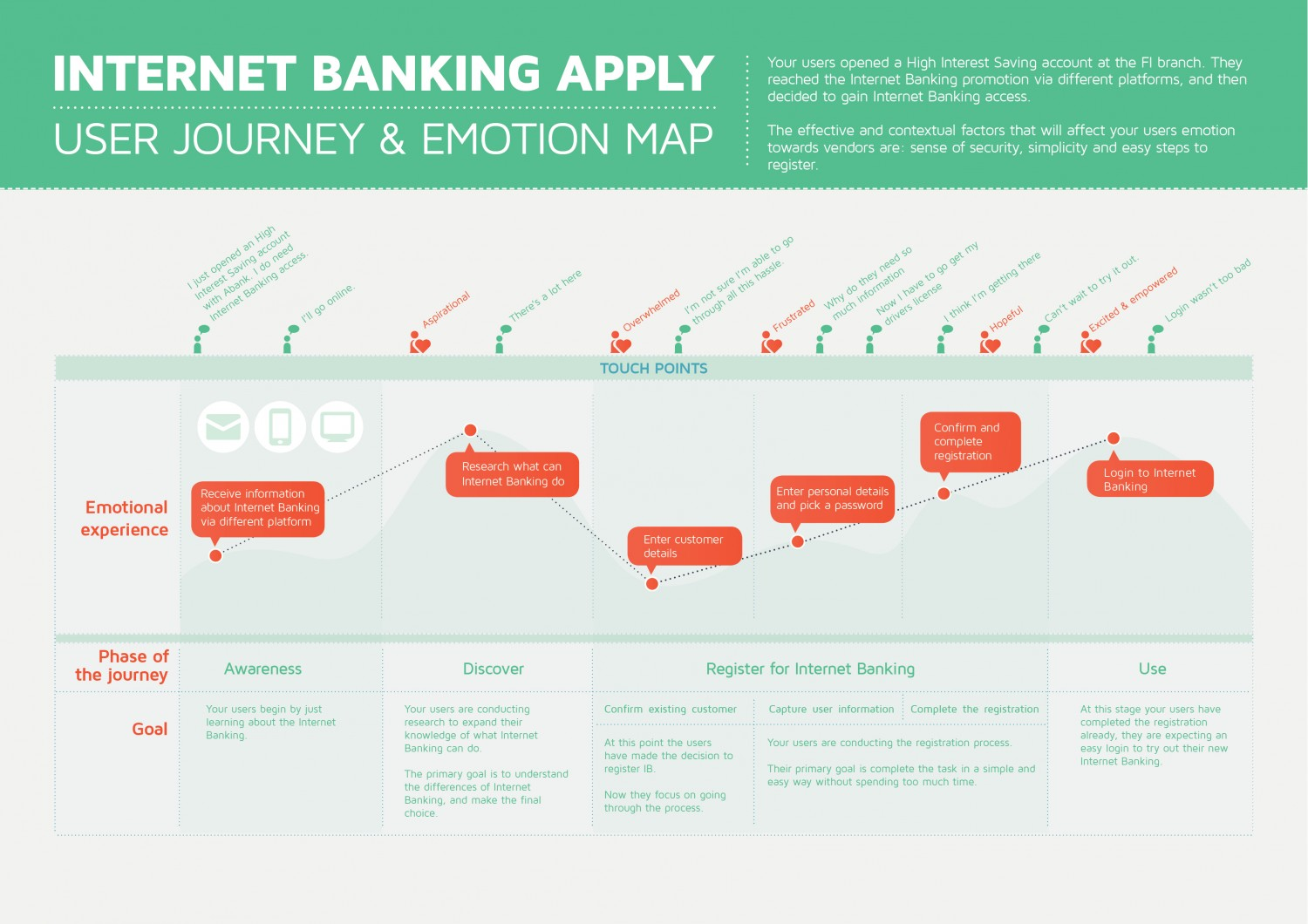
Why is it important to analyze and optimize the digital customer journey?
In today's digital age, businesses have to adapt to the changing customer behavior to remain competitive. As noted, customers have access to more information than ever before, which has made them more empowered and demanding. Therefore, businesses have to ensure that they are providing an exceptional customer experience at every touchpoint of the customer journey. This is where the analysis and optimization of the digital customer journey come in.
Importance of analyzing the digital customer journey
Analyzing the digital customer journey helps businesses understand how customers are interacting with their brand online. It provides insights into how customers are finding and engaging with their website, what content is resonating with them, and what pain points they're experiencing. This information helps businesses identify areas where they can improve the customer experience and increase conversions.
Optimizing the digital customer journey
Optimizing the digital customer journey involves making improvements to the touchpoints to provide a seamless and personalized customer experience. This includes optimizing the website's user experience, creating targeted content, and automating email communications. By doing this, businesses can reduce friction in the customer journey and increase the chances of conversion.
Benefits of analyzing and optimizing the digital customer journey
Analyzing and optimizing the digital customer journey provides several benefits to businesses, including:
Increased conversions: By reducing friction in the customer journey and providing a personalized experience, businesses can increase the chances of conversion.
Improved customer experience: By addressing pain points and providing relevant information, businesses can improve the customer experience and increase customer satisfaction.
Better insights: By analyzing the customer journey, businesses can gain valuable insights into customer behavior and preferences, which can inform marketing and product development strategies.
Competitive advantage: By providing an exceptional customer experience, businesses can differentiate themselves from competitors and increase customer loyalty.
How to analyze and optimize the digital customer journey
Now that we have a better understanding of the digital customer journey, we can explore how to analyze and optimize it. In this section, we will outline several key steps businesses can take to improve their digital customer experience.
Step 1: Understand Your Customers
To optimize the digital customer journey, businesses need to have a deep understanding of their customers. A great way to get started is building out customer personas. Personas are fictional representations of your ideal customers. They help build an understanding of your customers' needs, preferences, and behaviors - what you need to craft content and messages that resonate with them. To create customer personas, you need to gather demographic data, psychographic data, and behavioral data.
Step 2: Map Out the Customer Journey
Once businesses have a better understanding of their customers, they can create a customer journey map to visualize the various stages of the digital customer journey. Be sure to read our complete guide to customer journey mapping where we discuss how to create an effective customer journey map and provide examples.
Step 3: Identify Pain Points and Opportunities
With a customer journey map in place, businesses can identify pain points and opportunities for improvement. Leveraging digital analytics tools to identify points of friction at important touchpoints in the digital journey is imperative when trying to identify opportunities for optimization. Further on we’ll discuss how you can leverage digital experience intelligence to surface actionable insights connected to real pain points, low customer satisfaction scores and revenue loss.
Step 4: Improve Website Usability
A crucial aspect of optimizing the digital customer journey is improving website usability. One of the biggest deal-breakers for a potential buyer is the purchase process. Cart abandonment is almost 70% across industries. How can you make it seamless and fast? Offer multiple ways of paying, like digital wallets, one-click purchases and guest check out for new customers. Clearly state shipping and other costs prior to purchase. Activate omnichannel purchasing methods through social shopping and headless check out.
Step 5: Personalize the Experience
Personalization is becoming increasingly important in the digital customer journey. Ninety percent of customers are more likely to buy from a business that personalizes the customer experience. This can include product recommendations based on past browsing behavior, personalized email campaigns, customized landing pages and other ways to show that you recognize them as an individual buyer and value their time.
Step 6: Use Omnichannel Marketing: Providing a consistent brand experience
Omnichannel marketing involves reaching customers through multiple channels, such as email, social media, and mobile apps. Continually assessing and optimizing your omnichannel strategy ensures you’re providing a consistent brand experience across the touchpoints your customers will pass through as they traverse the different stages of the digital journey.
Step 7: Measure and Optimize
Finally, businesses need to continually measure and optimize the digital customer journey to ensure it is working effectively. Having access to tools which enable businesses to easily access the most meaningful insights is essential in a digital era – where the best digital experiences create loyal customer bases.
Below we will discuss the tools you need to get ahead.
The tools you need to get ahead
Typical data analytics can offer useful quantitative data, but digital experience intelligence takes insights far beyond these capabilities for macro and micro conversion points that matter most.
With a comprehensive suite of sophisticated tools, you can optimize the parts of the customer digital journey that will provide the most value to your customers, and in turn, your bottom-line.
The benefits of leveraging digital experience intelligence tools to analyze and optimize key touchpoints in the digital customer journey
There are many benefits to using tools to help you cut ahead and optimize areas that’ll add the most value to your customers and bottom line. Let’s take a look at some of them.
Identifying opportunities to fuel experimentation programs
By replaying exactly what the customer sees, product, marketing and IT departments can test website changes, website content, campaigns and even microsites before they go live. This allows for better workflows and journey optimization.
Site usability monitoring & IT troubleshooting
With 40% of consumers abandoning a website if a page takes more than three seconds to load and 53% abandoning a mobile site if it takes more than three seconds to load, site usability must be fine-tuned. The digital consumer has little patience, so monitoring usability can significantly impact the business. Customer acquisition, conversion rates, retention and even SEO rankings can be improved by analysis of experience and performance data.
Reproduce and diagnose errors
If something goes wrong (even if it’s not visible to the customer), performance data and access to session replays can immediately pinpoint what to fix. This helps with rapid diagnosis and problem solving and eliminates the need to tediously and repeatedly reproduce the error.
Improved customer experience
For the user experience designer, the purpose of journey mapping is to identify gaps and touchpoints in the customer experience that are disjointed or frustrating. These might be:
Difference in experience between devices, when a user moves from one device to another
Gaps and disconnects between content or site categories, where the user might get frustrated
Gaps between channels (for example, where the experience of going from social media to the website could be better)
According to a report from Forrester Research, “Understanding the specific devices, touchpoints and interactions is the only way to know if your digital investments will directly improve a customer experience.”
Most of all, a digital journey map puts the customer at the center of the organization’s thinking. It demonstrates how both mobile and web layouts impact customer behaviors.
What to look for in analytics tools for digital customer journey optimization: the functions you need to get ahead
There are certain features built into most digital analytics tools that will help you quickly understand key moments and impact in the customer journey. They include:
Augmented journey map: Get a visual, “big picture” view of where there are problems along the digital customer journey to identify and prioritize issues to fix.
Session replay: Find out the why of an issue on the path to purchase with capture and review of the entire interaction.
Struggle score: Analyze actions, behavioral patterns, and technical errors that help determine friction points in the customer journey causing problems for users.
Mobile crash analytics: One of the biggest causes of app abandonment is crashes. Find out how, where, and why that happened so you can fix the problem.
Now it’s time to understand where customers are struggling and why, as well as why digital marketing and sales funnel conversions are underperforming. The functions that can help you understand this that you should be looking for when considering tools for improving the digital customer experience are:
Funnels
You can decide on your own criteria for any marketing funnel in digital marketing, ideally by selecting a specific customer journey map for marketing (or maybe you have a tool that supports free-text search). For example, you might want to create a funnel of the entire purchase experience for all the traffic coming from Facebook. Then you can narrow it down to all the sessions where visitors spent more than 20 seconds on the “Special Offers” page but didn’t click to buy. With this data segmented into a digital marketing and sales funnel, you can start to understand the content marketing customer journey: why people struggle, where and why they are abandoning a transaction, and why they’re not converting.
Customer journey filters
To optimize customer experience on a particular page, try filtering your session replays by:
Mobile device
Operating system
Geographic location
Mouse movements
Customer demographics
Customer segment
Customer struggles
Traffic sources
Amount of time spent on page
These variables, and more, can help you to fine tune and understand who is struggling most, across which devices and locations, what issues were encountered and how to fix them for better outcomes.
Click maps
A click map shows you on average how many times a specific element was clicked, was changed (e.g. data populated in a field) and how much time was spent on it, within a given timeframe. Use analysis of this experience data to understand if the behavior of an individual customer or visitor is representative of the overall digital consumer behavior on a page or web element and if the issue you’re witnessing in a specific session is a wider problem experienced by many customers.
Abandonment rate indicator
More advanced customer mapping tools can give you an idea of where your customers are abandoning their journey to conversion and how often this occurs, allowing you to create a customer decision journey example. This helps you prioritize steps in the customer value journey to maximize your impact to revenue in the shortest amount of time.
Flexible data exporting
Everyone in the organization who is involved in customer journey strategy needs access to the data–IT, marketing, product, distribution and customer service. Choose a customer journey map solution that lets you export the raw customer journey data, real-time scenario-based data, or even batches of data so everyone has access to the digital truth.
Customer feedback through VoC
An integrated voice of customer tool connects what customers are saying with what they really experienced so you can analyze, prioritize and act on feedback quickly. But the issue is not all customers will leave feedback. In a customer experience capacity, this means you can switch gears and uncover VoC through user behavior and actions of the silent majority (voice of the silent). Leveraging this feedback and data allows teams to truly understand and optimize the customer journey.
Checkout our guide on customer journey maps and how to get started mapping them out.









